• Physics 17, s56
Adding neutrinos to an existing nucleosynthesis recipe can account for the puzzling existence of neutron-deficient heavy nuclei.
NOIRLab; NSF; AURA; J. da Silva/Spaceengine
Niobium-92 (92Nb) has just one fewer neutron than the element’s most abundant isotope niobium-93. Yet behind that seemingly insignificant difference lies a long-standing mystery. The two main pathways by which the Universe is thought to have created the elements heavier than iron involve the addition of neutrons to lighter elements. But they can’t account for the existence of 92Nb and other neutron-deficient nuclei (so-called p nuclei). Now Zewei Xiong of the GSI Helmholtz Centre for Heavy Ion Research in Germany and his collaborators have proposed a solution [1]. In the presence of copious neutrinos, one of the routes to heavy-element synthesis, the r process, can be diverted to make 92Nb and other p nuclei, such as molybdenum-92 and ruthenium-96.
The leading candidates for the locations of these nuclear reactions are supernovae and binary neutron-star mergers. Both sites are expected to abound in neutrinos. Ordinarily, the r process produces increasingly heavy elements as nuclei grow through a series of neutron-capture and -decay events. Xiong and his collaborators realized that neutrinos, if present in large numbers, could become absorbed by nuclei, thereby converting neutrons to protons and, conceivably, making p nuclei.
The researchers call their new mechanism the process. According to their calculations, the process requires large neutrino fluxes and temperatures around 3 billion kelvin. Xiong and his collaborators speculate that conditions favorable to the process occur in binary neutron-star mergers and rare types of supernovae with intense magnetic fields.
–Charles Day
Charles Day is a Senior Editor for Physics Magazine.
References
- Z. Xiong et al., “Production of p nuclei from r-process seeds: The process,” Phys. Rev. Lett. 132, 192701 (2024).




